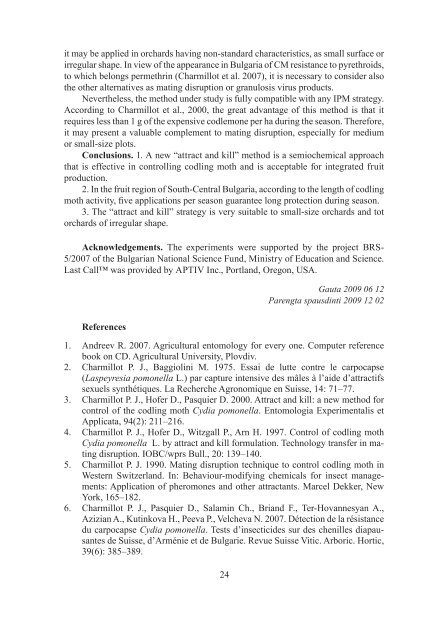SodininkyStÄ ir darŽininkyStÄ 28(4)
SodininkyStÄ ir darŽininkyStÄ 28(4)
SodininkyStÄ ir darŽininkyStÄ 28(4)
You also want an ePaper? Increase the reach of your titles
YUMPU automatically turns print PDFs into web optimized ePapers that Google loves.
it may be applied in orchards having non-standard characteristics, as small surface or<br />
<strong>ir</strong>regular shape. In view of the appearance in Bulgaria of CM resistance to pyrethroids,<br />
to which belongs permethrin (Charmillot et al. 2007), it is necessary to consider also<br />
the other alternatives as mating disruption or granulosis v<strong>ir</strong>us products.<br />
Nevertheless, the method under study is fully compatible with any IPM strategy.<br />
According to Charmillot et al., 2000, the great advantage of this method is that it<br />
requ<strong>ir</strong>es less than 1 g of the expensive codlemone per ha during the season. Therefore,<br />
it may present a valuable complement to mating disruption, especially for medium<br />
or small-size plots.<br />
Conclusions. 1. A new “attract and kill” method is a semiochemical approach<br />
that is effective in controlling codling moth and is acceptable for integrated fruit<br />
production.<br />
2. In the fruit region of South-Central Bulgaria, according to the length of codling<br />
moth activity, five applications per season guarantee long protection during season.<br />
3. The “attract and kill” strategy is very suitable to small-size orchards and tot<br />
orchards of <strong>ir</strong>regular shape.<br />
Acknowledgements. The experiments were supported by the project BRS-<br />
5/2007 of the Bulgarian National Science Fund, Ministry of Education and Science.<br />
Last Call was provided by APTIV Inc., Portland, Oregon, USA.<br />
Gauta 2009 06 12<br />
Parengta spausdinti 2009 12 02<br />
References<br />
1. Andreev R. 2007. Agricultural entomology for every one. Computer reference<br />
book on CD. Agricultural University, Plovdiv.<br />
2. Charmillot P. J., Baggiolini M. 1975. Essai de lutte contre le carpocapse<br />
(Laspeyresia pomonella L.) par capture intensive des mâles à l’aide d’attractifs<br />
sexuels synthétiques. La Recherche Agronomique en Suisse, 14: 71–77.<br />
3. Charmillot P. J., Hofer D., Pasquier D. 2000. Attract and kill: a new method for<br />
control of the codling moth Cydia pomonella. Entomologia Experimentalis et<br />
Applicata, 94(2): 211–216.<br />
4. Charmillot P. J., Hofer D., Witzgall P., Arn H. 1997. Control of codling moth<br />
Cydia pomonella L. by attract and kill formulation. Technology transfer in mating<br />
disruption. IOBC/wprs Bull., 20: 139–140.<br />
5. Charmillot P. J. 1990. Mating disruption technique to control codling moth in<br />
Western Switzerland. In: Behaviour-modifying chemicals for insect managements:<br />
Application of pheromones and other attractants. Marcel Dekker, New<br />
York, 165–182.<br />
6. Charmillot P. J., Pasquier D., Salamin Ch., Briand F., Ter-Hovannesyan A.,<br />
Azizian A., Kutinkova H., Peeva P., Velcheva N. 2007. Détection de la résistance<br />
du carpocapse Cydia pomonella. Tests d’insecticides sur des chenilles diapausantes<br />
de Suisse, d’Arménie et de Bulgarie. Revue Suisse Vitic. Arboric. Hortic,<br />
39(6): 385–389.<br />
24

















